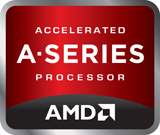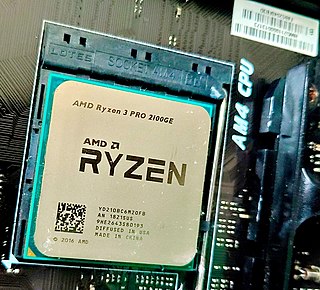Features overview
AMD IP x86 CPUs
| | This section is empty. You can help by adding to it. (March 2023) |
This article gives a list of AMD microprocessors, sorted by generation and release year. If applicable and openly known, the designation(s) of each processor's core (versions) is (are) listed in parentheses. For an overview over concrete product, you then need to consult further articles, like e.g. list of AMD accelerated processing units.
| | This section is empty. You can help by adding to it. (March 2023) |
Am9080 (second source for Intel 8080)
Am29X305 (second source for Signetics 8X305)
AMD Opteron A1100 Series
(second-sourced x86 processors produced under contract with Intel)
K10 series CPUs (2007–2013)
K10 series APUs (2011–2012)
Zen-based CPUs and some APUs use the Ryzen brand, while some APUs use the Athlon brand.


Zen series CPUs and APUs (released 2017)
Zen+ series CPUs and APUs (released 2018)
Zen 2 series CPUs and APUs (released 2019)
Zen 3 series CPUs and APUs (released 2020)
Zen 3+ series CPUs and APUs (released 2022)
Zen 4 series CPUs and APUs (released 2022)

Advanced Micro Devices, Inc. (AMD) is an American multinational corporation and semiconductor company based in Santa Clara, California, that develops computer processors and related technologies for business and consumer markets.

Athlon is the brand name applied to a series of x86-compatible microprocessors designed and manufactured by AMD. The original Athlon was the first seventh-generation x86 processor and the first desktop processor to reach speeds of one gigahertz (GHz). It made its debut as AMD's high-end processor brand on June 23, 1999. Over the years AMD has used the Athlon name with the 64-bit Athlon 64 architecture, the Athlon II, and Accelerated Processing Unit (APU) chips targeting the Socket AM1 desktop SoC architecture, and Socket AM4 Zen microarchitecture. The modern Zen-based Athlon with a Radeon Graphics processor was introduced in 2019 as AMD's highest-performance entry-level processor.
HyperTransport (HT), formerly known as Lightning Data Transport, is a technology for interconnection of computer processors. It is a bidirectional serial/parallel high-bandwidth, low-latency point-to-point link that was introduced on April 2, 2001. The HyperTransport Consortium is in charge of promoting and developing HyperTransport technology.

The Athlon 64 is a ninth-generation, AMD64-architecture microprocessor produced by Advanced Micro Devices (AMD), released on September 23, 2003. It is the third processor to bear the name Athlon, and the immediate successor to the Athlon XP. The Athlon 64 was the second processor to implement the AMD64 architecture and the first 64-bit processor targeted at the average consumer. Variants of the Athlon 64 have been produced for Socket 754, Socket 939, Socket 940, and Socket AM2. It was AMD's primary consumer CPU, and primarily competed with Intel's Pentium 4, especially the Prescott and Cedar Mill core revisions.
SSE3, Streaming SIMD Extensions 3, also known by its Intel code name Prescott New Instructions (PNI), is the third iteration of the SSE instruction set for the IA-32 (x86) architecture. Intel introduced SSE3 in early 2004 with the Prescott revision of their Pentium 4 CPU. In April 2005, AMD introduced a subset of SSE3 in revision E of their Athlon 64 CPUs. The earlier SIMD instruction sets on the x86 platform, from oldest to newest, are MMX, 3DNow!, SSE, and SSE2.
AMD PowerNow! is AMD's dynamic frequency scaling and power saving technology for laptop processors. The CPU's clock speed and VCore are automatically decreased when the computer is under low load or idle, to save battery power, reduce heat and noise. The lifetime of the CPU is also extended because of reduced electromigration, which varies exponentially with temperature.
The AMD K8 Hammer, also code-named SledgeHammer, is a computer processor microarchitecture designed by AMD as the successor to the AMD K7 Athlon microarchitecture. The K8 was the first implementation of the AMD64 64-bit extension to the x86 instruction set architecture.
AMD Cool'n'Quiet is a CPU dynamic frequency scaling and power saving technology introduced by AMD with its Athlon XP processor line. It works by reducing the processor's clock rate and voltage when the processor is idle. The aim of this technology is to reduce overall power consumption and lower heat generation, allowing for slower cooling fan operation. The objectives of cooler and quieter result in the name Cool'n'Quiet. The technology is similar to Intel's SpeedStep and AMD's own PowerNow!, which were developed with the aim of increasing laptop battery life by reducing power consumption.
The AMD Family 10h, or K10, is a microprocessor microarchitecture by AMD based on the K8 microarchitecture. The first third-generation Opteron products for servers were launched on September 10, 2007, with the Phenom processors for desktops following and launching on November 11, 2007 as the immediate successors to the K8 series of processors.

AMD Accelerated Processing Unit (APU), formerly known as Fusion, is a series of 64-bit microprocessors from Advanced Micro Devices (AMD), combining a general-purpose AMD64 central processing unit (CPU) and 3D integrated graphics processing unit (IGPU) on a single die.
Zen is the codename for a family of computer processor microarchitectures from AMD, first launched in February 2017 with the first generation of its Ryzen CPUs. It is used in Ryzen, Ryzen Threadripper, and Epyc (server).

Zen is the codename for the first iteration in a family of computer processor microarchitectures of the same name from AMD. It was first used with their Ryzen series of CPUs in February 2017. The first Zen-based preview system was demonstrated at E3 2016, and first substantially detailed at an event hosted a block away from the Intel Developer Forum 2016. The first Zen-based CPUs, codenamed "Summit Ridge", reached the market in early March 2017, Zen-derived Epyc server processors launched in June 2017 and Zen-based APUs arrived in November 2017.

Zen 2 is a computer processor microarchitecture by AMD. It is the successor of AMD's Zen and Zen+ microarchitectures, and is fabricated on the 7 nm MOSFET node from TSMC. The microarchitecture powers the third generation of Ryzen processors, known as Ryzen 3000 for the mainstream desktop chips, Ryzen 4000U/H and Ryzen 5000U for mobile applications, as Threadripper 3000 for high-end desktop systems, and as Ryzen 4000G for accelerated processing units (APUs). The Ryzen 3000 series CPUs were released on 7 July 2019, while the Zen 2-based Epyc server CPUs were released on 7 August 2019. An additional chip, the Ryzen 9 3950X, was released in November 2019.

Ryzen is a brand of multi-core x86-64 microprocessors designed and marketed by Advanced Micro Devices (AMD) for desktop, mobile, server, and embedded platforms based on the Zen microarchitecture. It consists of central processing units (CPUs) marketed for mainstream, enthusiast, server, and workstation segments and accelerated processing units (APUs) marketed for mainstream and entry-level segments and embedded systems applications.
Zen+ is the codename for a computer processor microarchitecture by AMD. It is the successor to the first gen Zen microarchitecture, and was first released in April 2018, powering the second generation of Ryzen processors, known as Ryzen 2000 for mainstream desktop systems, Threadripper 2000 for high-end desktop setups and Ryzen 3000G for accelerated processing units (APUs).

Zen 4 is the codename for a CPU microarchitecture designed by AMD, released on September 27, 2022. It is the successor to Zen 3 and uses TSMC's N6 process for I/O dies, N5 process for CCDs, and N4 process for APUs. Zen 4 powers Ryzen 7000 performance desktop processors, Ryzen 8000G series mainstream desktop APUs, and Ryzen Threadripper 7000 series HEDT and workstation processors. It is also used in extreme mobile processors, thin & light mobile processors, as well as EPYC 8004/9004 server processors.

Zen 3 is the codename for a CPU microarchitecture by AMD, released on November 5, 2020. It is the successor to Zen 2 and uses TSMC's 7 nm process for the chiplets and GlobalFoundries's 14 nm process for the I/O die on the server chips and 12 nm for desktop chips. Zen 3 powers Ryzen 5000 mainstream desktop processors and Epyc server processors. Zen 3 is supported on motherboards with 500 series chipsets; 400 series boards also saw support on select B450 / X470 motherboards with certain BIOSes. Zen 3 is the last microarchitecture before AMD switched to DDR5 memory and new sockets, which are AM5 for the desktop "Ryzen" chips alongside SP5 and SP6 for the EPYC server platform and sTRX8. According to AMD, Zen 3 has a 19% higher instructions per cycle (IPC) on average than Zen 2.